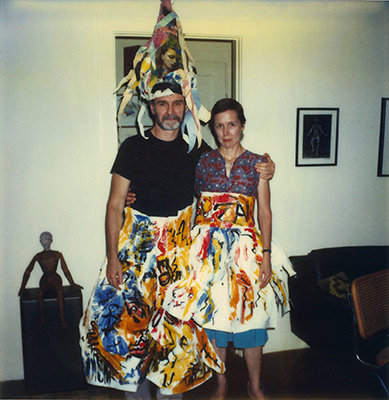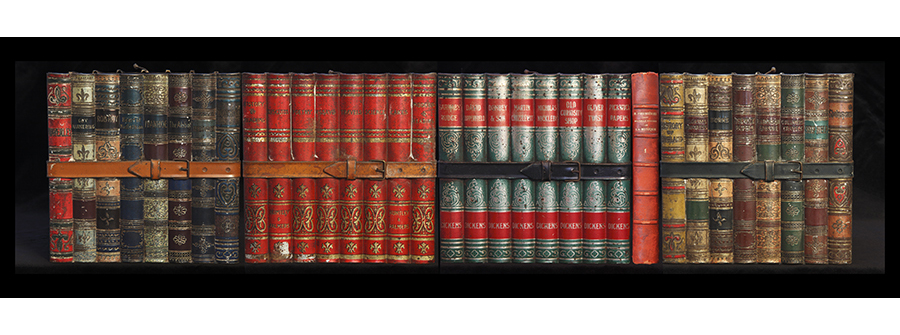about
above: La Musique, 2011, archival pigment print, 18″ x 62″
Our artistic collaboration began as a creative experiment in 1974 and has endured for four decades. In the spirit of the 1960s-70s, we chose to call ourselves MANUAL, a word with several connotations open to numerous interpretations. At this point our surnames have been added to our collective nom d’artiste. We met as art faculty teaching at Smith College in Northampton, Massachusetts, and in 1976 were invited by George Bunker, chair of the then Department of Art, to teach at the University of Houston in Houston, Texas. Houston is an excellent environment for artists/photographers, however with rare exceptions, summer months and periodic sabbaticals were spent making art in rural Vershire, Vermont. Since retiring from teaching, we have divided our time more equally between studios in Houston and Vershire.
Throughout our collaboration, we have tended to work in discrete but extended projects. The series of fourteen works in the early Art in Context project, for example, span six years (1974-80), The Trouble with Arcadia, twenty-five works, span four years (1998-2002), and the 120 works in VIDEOLOGY, were made over two years (1983-84).
We are now in year six of our Book Project, which includes fifty-three works in Books I (2010), thirty-six pieces in Books II (2012), and seventeen in Books III (2013-14). We expect more will appear in a Books IV section soon. Essentially, with this project, we are operating within the classic genre of still life, although it feels much more as though we are staging discrete dramas on a very small stage. Solo or ensemble (a single book or many), with or without additional costumes, props, or flats these images are each intended to remind us that books—the work horses of autodidacts and patient love objects of bibliophiles—are sensitive to our neglect or disregard. They have been and still are created for and by human intercourse. What we may be doing in this extended project is just a different form of “romance” with the book than is reading and researching.
Now and Then, which we began in 2013, is another of our on-going projects. The title is a play on both a commonly used phrase and the complex concept of temporality. The work in the series, nine pieces to date, reflects the striking changes—precipitated by rapid developments in digital media—that have taken place in the image making process since the mid-1990s. Like a tidal wave, digital photography has superseded and ultimately displaced pre-digital photography as the predominant means of production. [In 2000, we purchased our first digital camera, the Nikon D1, a year after it became one of the first professional digital SLR cameras on the market.] This is true not only of the cameras and processes of production, such as the traditional B&W gelatin silver, but also of the various means that were used to distribute photo-material, such as magazines, postcards, and slides. The work in Now and Then signals the end of an era and a fusion of past and present lens-based imagery—current technology reframing previous technologies.
Our latest project, Raising Nature began with the recognition that we’d been sequestered in the studio for too long and needed to get outdoors to work in nature again. This was in early summer, 2014, and it was a return to a familiar subject for us. We’d focused on the problems of representing Nature in strong but non-cliched ways a number of times before. In the project 13 Ways of Coping with Nature (1981-82), using a 4 X 5 camera, we made thirteen photographs of collaged, mixed media imagery, showing everything from a drawing of a deer with an attached deer skull to a large quartz rock illuminated with red and green light simulating an anaglyph stereo image. We also wrote a poem for the project based on the form of poet Wallace Stevens’ 13 Ways of Looking at a Blackbird. In the poem, among other things, we ask, “Can ecological thought help ART?”, and, “Art imitates [our idea of] Nature.”
In the early and mid-1990s we produced two major projects related to Raising Nature in which trees and forests were the main protagonists: FOREST\PRODUCTS (1991), and A Constructed Forest (1993). The first of these two examined Nature in relation to the forest industry; the second focused on the relation between the Real and the Virtual (for example, real versus simulated wood). This was a burgeoning cultural and ecological issue at that time compared to its ubiquity in our current Digital Age.
At the end of the 90s we began the Arcadia project, a six-year long undertaking, which had been inspired by artist-art historian Stephen Hobson’s interpretation of the role of the UVO elements (unidentified virtual objects) in our imagery from the series Two Worlds (see: Archive/1990-1996/Two Worlds). His comments led us to reconsider the importance of French 17th-century artist Nicolas Poussin, and in particular the significance of his famous 1637-38 painting, The Arcadian Shepherds. The painting depicts a pastoral scene in which four shepherds are gathered around a tomb in the woods inquisitively examining its inscription, Et In Arcadia Ego (Even in Arcadia, there am I). Our response to the ambiguous question of whom or what is in the tomb was to suggest that it might be endangered Nature herself—even in idyllic, pastoral landscapes.
The specific difference between the work in these previous projects dealing with the natural world and our current project, Raising Nature, is the inclusion in the latter of the passage of time as a pictorial element. In each image, recorded time has been compressed into a single frame with the goal that it would act as a kind of time-release capsule for the viewer. Given the notoriously brief encounters that define contemporary art viewing, this may be, realistically, a “goal” only rarely scored.
Please look for more information about M A N U A L on Houston-based Moody Gallery’s site: www.moodygallery.com
below: Ed Hill and Suzanne Bloom, Houston, late-1980s

